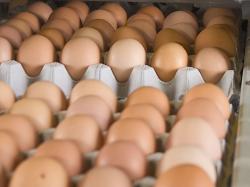Egg-Production Practices Meet Demand & Maintain Hen Well-Being
May 3, 2010 | 1 min to read

UNIVERSITY PARK, Pa. — As the public and various interest groups debate the relative pros and cons of different egg-production practices and poultry-housing options, poultry scientists in Penn State’s College of Agricultural Sciences say modern, science-based methods are helping to meet consumer demand for safe and nutritious eggs.
Advantages or disadvantages
Whether production practices utilize conventional cages or cage-free methods, researchers and producers have found advantages and disadvantages in each system for the birds, for farmers and for consumers.
“As it stands now, consumers have choices, such as whether eggs are produced in conventional housing or cage-free, whether eggs have white or brown shells, whether eggs have higher levels of nutrients such as omega-3 fatty acids, or whether they were produced under certified-organic guidelines,” said Gregory Martin, a Penn State Cooperative Extension poultry educator based in Lancaster County.
To read the rest of this story please go to: Farm And Dairy
